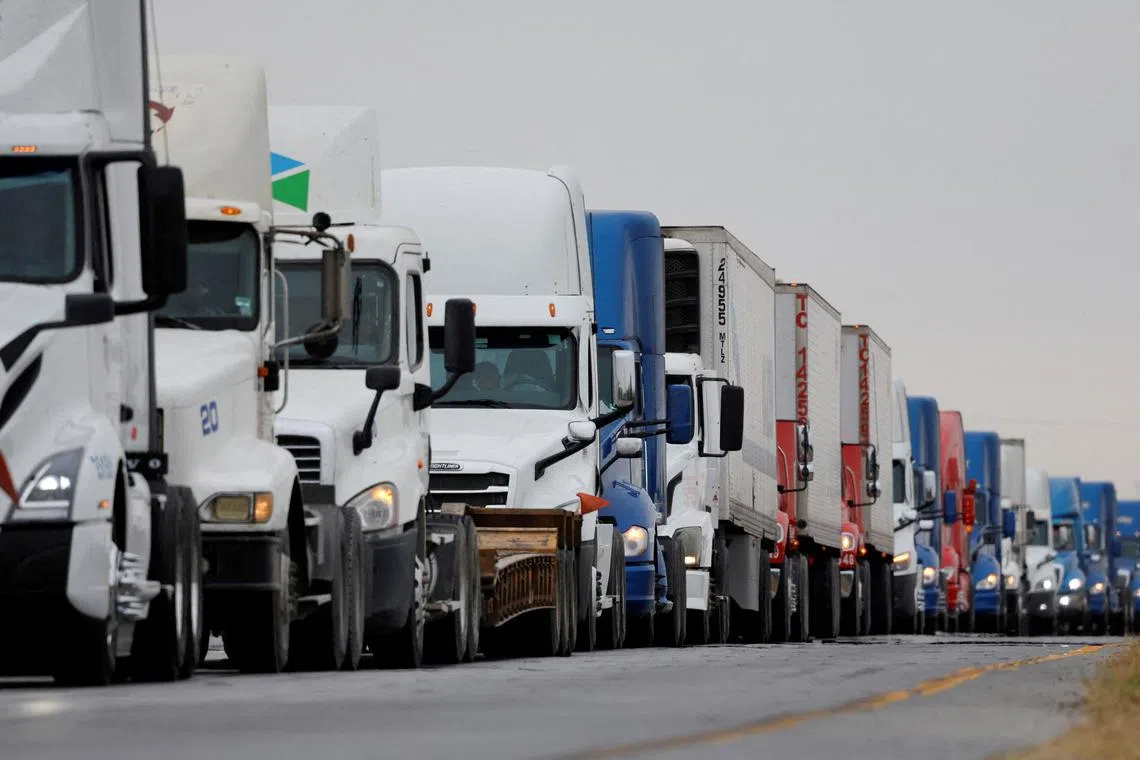Trade wars erupt as Trump hits Canada, Mexico, China with steep tariffs
Sign up now: Get ST's newsletters delivered to your inbox

Canada and Mexico were poised to immediately retaliate against their long-time ally.
PHOTO: REUTERS
Follow topic:
WASHINGTON – US President Donald Trump’s new 25 per cent tariffs on imports from Mexico and Canada
The tariff actions, which could upend nearly US$2.2 trillion (S$3 trillion) in two-way annual US trade, went live at 12.01 Eastern Standard Time, hours after Mr Trump declared that all three countries failed to do enough to stem the flow of the deadly fentanyl opioid and its precursor chemicals into the United States.
China responded immediately after the deadline, announcing additional tariffs of 10 per cent to 15 per cent on certain US imports from March 10 and a series of new export restrictions for designated US entities.
Canada and Mexico, which have enjoyed a virtually tariff-free trading relationship with the US for three decades, were poised to immediately retaliate against their long-time ally.
Canadian Prime Minister Justin Trudeau said Ottawa would respond with immediate 25 per cent tariffs on C$30 billion (S$28 billion) worth of US imports, and another C$125 billion if Mr Trump’s tariffs were still in place in 21 days.
He said previously that Canada would target American beer, wine, bourbon, home appliances and Florida orange juice.
“Tariffs will disrupt an incredibly successful trading relationship,” Mr Trudeau said, adding that they would violate the US-Mexico-Canada free trade agreement signed by Mr Trump during his first term.
Ontario Premier Doug Ford told NBC he was ready to cut off shipments of nickel and transmission of electricity from his province to the US in retaliation.
Mexican President Claudia Sheinbaum, who said there was no justification for the tariffs, was expected to announce her country’s response on March 9, according to reports.
Stacking China tariffs
The extra 10 per cent duty on Chinese goods adds to a 10 per cent tariff imposed by Mr Trump on Feb 4 to punish Beijing over the US fentanyl overdose crisis.
The cumulative 20 per cent duty also comes on top of tariffs of up to 25 per cent imposed by Mr Trump during his first term on some US$370 billion worth of US imports.
Some of these products saw US tariffs increase sharply under former president Joe Biden in 2024, including a doubling of duties on Chinese semiconductors to 50 per cent and a quadrupling of tariffs on Chinese electric vehicles to over 100 per cent.
The 20 per cent tariff will apply to several major US consumer electronics imports from China previously untouched by prior duties, including smartphones, laptops, video-game consoles, smartwatches and speakers and Bluetooth devices.
China’s new tariffs announced on March 4 targeted a wide range of US agricultural products, including certain meats, grains, cotton, fruit, vegetables and dairy products.
Beijing also placed 25 US firms under export and investment restrictions on national security grounds. Ten of these firms were targeted for selling arms to Taiwan.
China’s Commerce Ministry said the US tariffs violated World Trade Organisation rules and “undermine the basis for economic and trade cooperation between China and the US”.
US farmers were hard hit by Mr Trump’s first-term trade wars, which cost them about US$27 billion in lost export sales and conceded share of the Chinese market to Brazil.
Recession fears
The tariffs on Mexican and Canadian products could have much deeper repercussions for a highly integrated North American economy that depends on cross-border shipments to build cars and machinery, refine energy and process agricultural goods.
“Today’s reckless decision by the US administration is forcing Canada and the US towards recessions, job losses and economic disaster,” Canadian Chamber of Commerce chief executive Candace Laing said in a statement.
She said the US tariffs will fail to usher in a “golden age” coveted by Mr Trump, but instead raise costs for consumers and producers, and disrupt supply chains.
“Tariffs are a tax on the American people,” she said.
Mr Matt Blunt, president of the American Automotive Policy Council representing Detroit carmakers, called for vehicles that meet the US-Mexico-Canada agreement’s regional content requirements to be exempted from the tariffs.
Even before Mr Trump’s tariffs announcement, US data on March 3 showed factory gate prices jumped to a nearly three-year high, suggesting that a new wave of tariffs could soon undercut production.
Mr Trump’s confirmation that the tariffs would proceed sent financial markets reeling
Piling on
Mr Trump has maintained a blistering pace of tariff actions since taking office in January, including fully restored 25 per cent tariffs on steel and aluminium imports that take effect on March 12, rescinding prior exemptions.
Mr Trump’s “America First” agenda, aimed at redrawing trade relationships in favour of the US, is expected to be a centrepiece of his address on March 5 to a joint session of Congress.
Mr Trump on March 1 opened a national security investigation into imports of lumber and wood products
A week earlier, Mr Trump revived a probe into countries that levy digital services taxes, proposed fees of up to US$1.5 million on every Chinese-built ship entering a US port and launched a tariff investigation into copper imports.
These add to his plans for higher “reciprocal tariffs” to match the levies of other countries and offset their other trade barriers, a move that could hit the European Union hard. REUTERS

